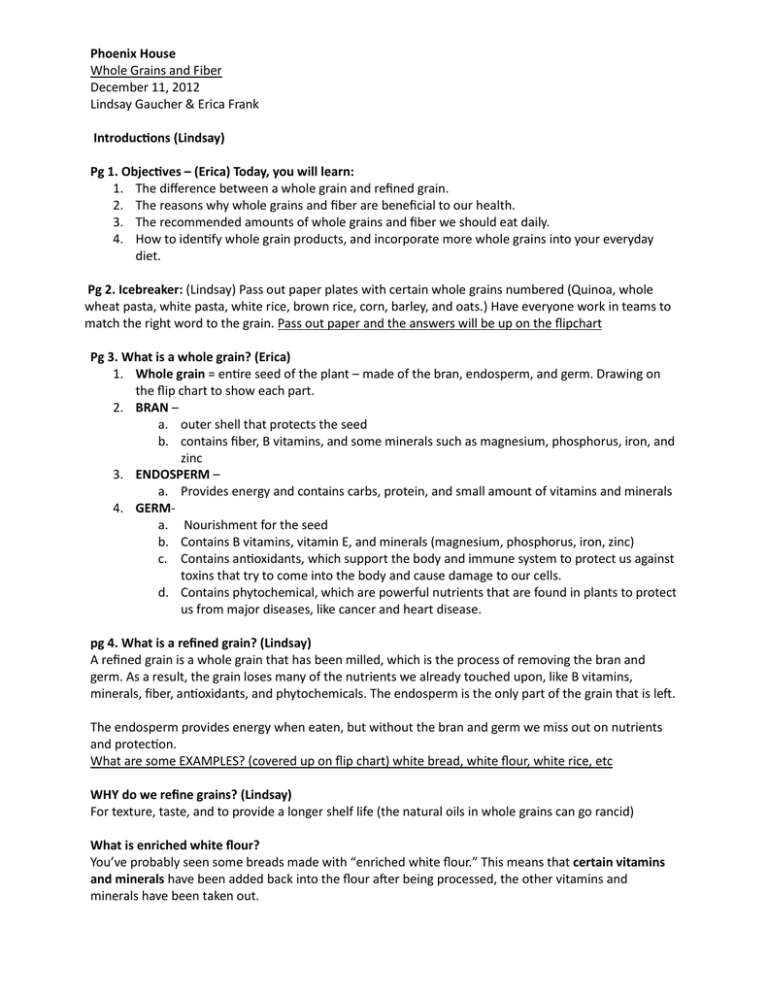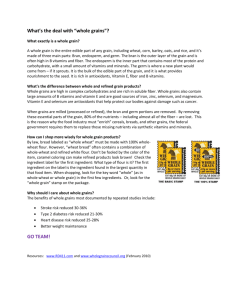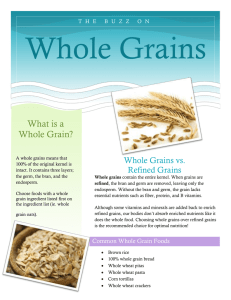Whole Grains and Fiber
advertisement

Phoenix House Whole Grains and Fiber December 11, 2012 Lindsay Gaucher & Erica Frank Introductions (Lindsay) Pg 1. Objectives – (Erica) Today, you will learn: 1. The difference between a whole grain and refined grain. 2. The reasons why whole grains and fiber are beneficial to our health. 3. The recommended amounts of whole grains and fiber we should eat daily. 4. How to identify whole grain products, and incorporate more whole grains into your everyday diet. Pg 2. Icebreaker: (Lindsay) Pass out paper plates with certain whole grains numbered (Quinoa, whole wheat pasta, white pasta, white rice, brown rice, corn, barley, and oats.) Have everyone work in teams to match the right word to the grain. Pass out paper and the answers will be up on the flipchart Pg 3. What is a whole grain? (Erica) 1. Whole grain = entire seed of the plant – made of the bran, endosperm, and germ. Drawing on the flip chart to show each part. 2. BRAN – a. outer shell that protects the seed b. contains fiber, B vitamins, and some minerals such as magnesium, phosphorus, iron, and zinc 3. ENDOSPERM – a. Provides energy and contains carbs, protein, and small amount of vitamins and minerals 4. GERMa. Nourishment for the seed b. Contains B vitamins, vitamin E, and minerals (magnesium, phosphorus, iron, zinc) c. Contains antioxidants, which support the body and immune system to protect us against toxins that try to come into the body and cause damage to our cells. d. Contains phytochemical, which are powerful nutrients that are found in plants to protect us from major diseases, like cancer and heart disease. pg 4. What is a refined grain? (Lindsay) A refined grain is a whole grain that has been milled, which is the process of removing the bran and germ. As a result, the grain loses many of the nutrients we already touched upon, like B vitamins, minerals, fiber, antioxidants, and phytochemicals. The endosperm is the only part of the grain that is left. The endosperm provides energy when eaten, but without the bran and germ we miss out on nutrients and protection. What are some EXAMPLES? (covered up on flip chart) white bread, white flour, white rice, etc WHY do we refine grains? (Lindsay) For texture, taste, and to provide a longer shelf life (the natural oils in whole grains can go rancid) What is enriched white flour? You’ve probably seen some breads made with “enriched white flour.” This means that certain vitamins and minerals have been added back into the flour after being processed, the other vitamins and minerals have been taken out. As we’ve talked about in past presentations, food is more powerful in its whole form. So when we eat all parts of the grain, we benefit more from it. So now we’ll jump into why it is so important to eat whole grains. Pg 5. Benefits of eating whole grains (Erica) Provides us with energy (remember the endosperm is the part that is responsible for energy) Helps keep us feeling full longer – this is due to the amount of fiber that is in a whole grain and the fact that it takes longer for the digestive tract to process whole grains Can help stabilize blood sugars – ties into the breakdown and process the body has for whole grains. Provides ALL the nutrients from the grain (vitamins, minerals, antioxidants, phytochemicals) Helps control weight – again, ties into the feeling of fullness for a longer period and the fiber Reduces the risk for heart disease, DM, stroke, colon cancer (research shows if you don’t eat enough whole grains there is a link to colon cancer because of increased stool weight.) (Erica & Lindsay) Let’s play BINGO! Lindsay and Erica to take turns calling out BINGO. For each word explain the relationship to whole grains and/or benefits when it comes eating whole grains. *See separate BINGO sheet for game Pg 6 What is FIBER? (Lindsay) We’ve mentioned fiber quite a few times. Many of the health benefits we have already discussed are because of fiber! FIBER = includes all parts of a plant food (fruits, veggies, grains) cannot be broken down/digested in digestive tract. There are 2 types of fiber, do you remember them from our discussion last week? (covered up) SOLUBLE- attracts water and turns to a gel-like substance as it works its way through the digestive tract. Eating soluble fiber helps slow down the digestion process and can control blood sugar levels because sugar and carbohydrates that are digested leave the stomach more slowly. Soluble fiber can also help reduce cholesterol levels by clinging to cholesterol and moving it out of the body. You’ll find a lot of soluble fiber in oats and barley, and other foods with these types of whole grains. INSOLUBLE – Does not dissolve in water and instead soaks up some water to add bulk to stool. This helps food pass quickly through the intestines, and prevents constipation, and other related bowel issues. You will find insoluble fiber in wheat, bran, and other whole grains. *Many whole grain products have both soluble and insoluble fiber. Pg 7 What are the recommended amounts of fiber and whole grains? (Erica) The U.S. Guidelines actually say you should eat a specified number of "ounce-equivalents" instead of servings, this is because a slice of most breads, a cup of most cold cereals, and the amount of ½ cup COOKED dry rice or pasta all weigh about an ounce. If ounces are hard to remember, here’s an easy way to remember: MyPlate visual – Show the place mat. Generally, more than a ¼ of our diet everyday should consist of grains (5-7 servings), and it is recommended that HALF should be WHOLE grains, which is about 3-5 servings. The exact amount is different for everyone based on your age, gender, and activity level. Here are some examples of a serving, also one oz equivalents. Using your hand or other objects as a visual can help too! -1/2 cup cooked rice, pasta, or cereal (cupped hand) -1 slice bread (size of a CD case) -1 cup ready-to-eat cereal (your fist or a tennis ball) FIBER recommendations 25 grams for women 35 grams for men *When 100% whole grain products are eaten, it is typically really easy to meet these recommendations! Pg 8 Identifying Whole Grains (Lindsay) The Whole Grains Council has created an official packaging symbol called the Whole Grain Stamp that helps consumers find real whole grain products. (Copy of stamp on flip chart) The stamp continues to be placed on products everyday. 100% whole grain with at least 16g of whole grain, and regular whole grain with 8 g which may also contain some refined grains. Shoot for at least 3 servings of products with the 100% whole grain stamp or 6 servings of the other stamp and you will meet the daily recommended amount! What if a stamp isn’t on a product you’re looking at? The best way is by looking at the nutrition label and ingredients list! The first 2 ingredients in a whole grain product will most likely contain the term “whole” or the name of the grain itself. These are common ingredients that will indicate a whole grain product: Whole wheat Barley Stoneground whole wheat or grain Quinoa Brown rice buckwheat Oats, oatmeal wheat berries Both fiber and whole grains have been shown to have health benefits, but they're not interchangeable. So checking the fiber on a label is not a very reliable way to guess whether a product is truly whole grain. Although it’s the color brown doesn’t necessarily make it a whole grain! Manufacturers add colors/flavors to products to enhance flavor and market healthfulness, so that doesn’t mean whole grains were actually used. PASS OUT the HANDOUT! On the back is a chart with common grain (whole and refined) ingredients. Pg 9 Food label activity (Lindsay & Erica) we can both write on the flip chart and switch off asking each group for their thoughts Everyone will work in teams of 2-3. Provide different grain products and ask the groups to look at the ingredient lists/any seals and write down the key ingredients/seal that make the product a grain/whole grain. Use the handout for help with any terms. On the flip chart will be the name of the products and we will write their answers. Is your product a WHOLE grain or refined grain? Pg 10 So how can you incorporate more whole grains? (Erica) Ask them if they can tell us the remaining answers covered up on the flip chart Switch to whole wheat/whole grain versions of bread, wraps, pasta, bagels, cereal, rice, etc Try oatmeal Use whole wheat flour when baking Snack on popcorn Add grains to soups and salads (barley soup, quinoa salad, rice salad) FOOD ACTIVITY: Quinoa Salad (Erica) pass out prepared samples Easy to make and demonstrates a healthy meal to incorporate whole grains with added nutrients! Pg 11 JEOPARDY (Evaluation) – Lindsay & Erica Split the group into 3 teams. Team 1 picks question, read questions from paper, first one to raise hand and answer gets the points noted. CATEGORIES : Teams can only see the number of points on flip chart which will coordinate to the questions What are whole grains? (Lindsay) 100 – what are the parts of a whole grain? Bran, endosperm, germ 200- what part of the kernel is lost when a whole grain is refined? Endosperm 300- Give an example of a whole grain. i.e corn, oats, whole wheat, brown rice, quinoa, barley, etc Benefits of Whole grains (Erica) 100 – Name one disease or condition that whole grains can help to prevent. Diabetes, heart disease, cancer, obesity 200- Why do whole grains help to keep us feeling full? Fiber 300- Name 2 vitamins and/or minerals a whole grain has. B vitamins, Vitamin E, magnesium, iron, phosphorus, zinc Identifying Whole Grains (Lindsay) 100- How can you identify a whole grain? Check ingredient lists, check for whole grain seals 200- Name a word you would see on an ingredient list to indicate that the product is a whole grain. Whole wheat/grain, oats, barley, brown rice, etc 300- Name 2 ways to incorporate whole grains – switch to whole grain/wheat bread, pasta, rice, etc. Snack on popcorn, add to soups and salad. Serving Sizes and Recommendations (Erica) 100 – Remember the MyPlate visual? How much of your plate should contain grains? ¼ of your plate 200- How many gram of fiber is recommended for women? 25 grams 300- It is recommended that at least _____ of your grains be whole. Half Pg 12- Thank you!/CALL TO ACTION: (Lindsay) Check out ingredient lists, look for the whole grain seals, and make a healthy switch to incorporate more whole grains into your diet everyday! References : http://www.wholegrainscouncil.org www.Mayoclinic.com/health/health-foods/MY01108&slide=5 www.usda.gov/wholegrains http://www.choosemyplate.gov/food-groups/grains.html





